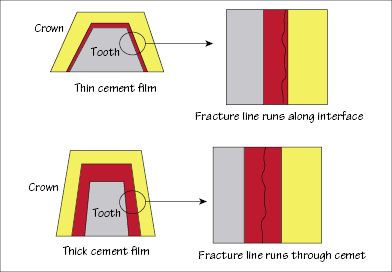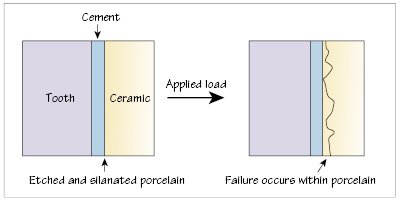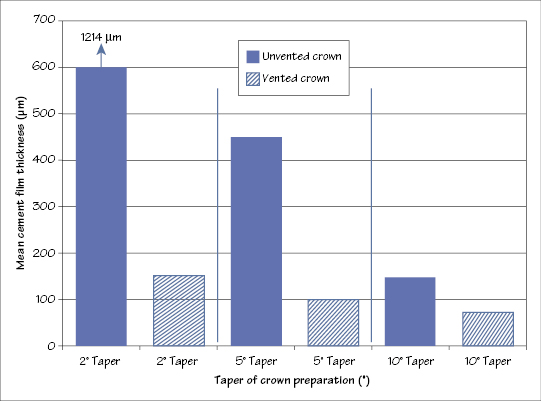25
Dental luting
Figure 25.1 Failure patterns for thin and thick cement films beneath crowns. (From Fundamentals of Fixed Prosthodontics; M. Palermo and J.A. von Fraunhofer, Wiley-Blackwell, 2013.)

Figure 25.2 Bond strength of adhesive to etched and silanated porcelain exceeds the cohesive strength of porcelain. (From Fundamentals of Fixed Prosthodontics; M. Palermo and J.A. von Fraunhofer, Wiley-Blackwell, 2013.)

Figure 25.3 Cement film thicknesses in µm beneath vented and unvented full-coverage crowns for different taper angles.

Technically, cements are substances that “set,” but dental cements are luting agents or “lutes” used to bond prostheses to prepared teeth or implants. Thus dental cements are bonding agents (adhesives) that hold prostheses in place through strong interfacial forces.
Three broad categories of dental cements exist: those providing a protective action (liners and bases, Chapter 26); those that are temporary (provisional) luting agents (Chapter 27); and those for permanent luting of restorations (Chapters 28–30). Traditionally, dental cements were inorganic zinc oxide–based materials but now resin-based materials predominate.
Ideally, cements should wet both the hard tissue substrate and the prosthesis, and provide either a strong chemical interaction or mechanical interlocking with both surfaces. Additionally, the cement should possess long-term stability in use, i.e. exhibit good cohesion (high internal strength); see Box 25.1.
The adhesive layer between restoration and tooth should be as thin as possible so that the cement–tooth and cement–restoration interfacial adhesions exceed the cement cohesive strength, maximizing the shear force required to overcome interfacial retentive forces. Where there are undercuts or poor fit between restoration and tooth, the cement layer thickness increases to fill the gap during restoration placement a/>
Stay updated, free dental videos. Join our Telegram channel

VIDEdental - Online dental courses


